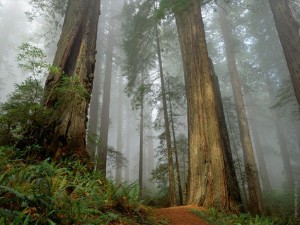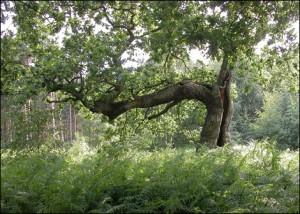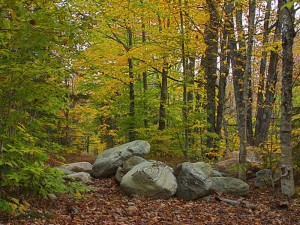 If you are looking for inspiration when designing encounter maps may I make a recommendation?
If you are looking for inspiration when designing encounter maps may I make a recommendation?
Take a hike.
That’s right, get out into nature. Go to the source and see what things really look like. Then decide if it makes sense for a square to be difficult terrain or not? Does light foliage really grant concealment? If you really want an answer to these and other questions, take a walk through your local forest. Your eyes will be opened to a new set of possibilities and you might discover a new past time.
I was out hiking the other day with Sterling, we were doing a leg of the Bruce Trail. As we passed a small cliff one of us piped up that it would make a great location for an ambush. To which the other replied, how many rounds do you think it would take to run towards the cliff and scale it? From there the conversation moved to an analysis of the terrain, the density of the trees and how much cover they provided.
Most encounters in 4e D&D that I have seen haven’t used a map that is really big enough to represent the terrain and space that might really be at play. This is especially true for outdoor encounters. When you consider how far a longbow can really shoot, you realize that most maps are far too small. However, we need to work within the conventions of the game in order to provide balance and an enjoyable gaming experience. One thing I have noted about most maps is they tend to have a fair amount of open terrain, squares that don’t have any special conditions attached to them.
 In our modern world of roads, sidewalks and manufactured green spaces this might make sense. Take a walk ten minutes outside of a major urban centre and you start to realize that not everything is flat. While running through a field might not be difficult terrain, depending on the height of the grass it could provide partial cover. If the grass is tall enough or you set the encounter in a corn field, more than partial cover would be granted and each square would be difficult terrain.
In our modern world of roads, sidewalks and manufactured green spaces this might make sense. Take a walk ten minutes outside of a major urban centre and you start to realize that not everything is flat. While running through a field might not be difficult terrain, depending on the height of the grass it could provide partial cover. If the grass is tall enough or you set the encounter in a corn field, more than partial cover would be granted and each square would be difficult terrain.
Forested space should be considered in the same light. Take a walk through your local forest and look at the space that’s off the path. Ask yourself how much cover would you receive based on the D&D definitions. Would the terrain be considered difficult? I’ve found there is no better way to put a realistic tactical map together than to look at the source.
 Dungeon Tiles are great for building a map quickly. They really are a great resource, but they do have a shortcoming. Most wilderness Dungeon Tiles that I’ve seen are full of wide open spaces with a few random trees. This might do the trick if every encounter you ever run occurs on grasslands. However, every major game world I can think of has at least one very large and significant forested area.
Dungeon Tiles are great for building a map quickly. They really are a great resource, but they do have a shortcoming. Most wilderness Dungeon Tiles that I’ve seen are full of wide open spaces with a few random trees. This might do the trick if every encounter you ever run occurs on grasslands. However, every major game world I can think of has at least one very large and significant forested area.
Of course doing the researching and then designing the map are two different things. Fortunately there are a couple of great free resources that you can use to assist in designing your map. The first is Google Earth which is great for getting a topographical sense of terrain anywhere in the world.
 The second resource is Gozzy’s random wilderness map generator. What I like about this random map generator is even on a map with a low foliage setting, there are still a lot of trees. That opens up the ability to make certain squares difficult terrain and to provide a great deal of cover. The generator also has the ability to insert a path, ruins, and water. This gives you a great deal of control about what will appear and you’re guaranteed a different map every time.
The second resource is Gozzy’s random wilderness map generator. What I like about this random map generator is even on a map with a low foliage setting, there are still a lot of trees. That opens up the ability to make certain squares difficult terrain and to provide a great deal of cover. The generator also has the ability to insert a path, ruins, and water. This gives you a great deal of control about what will appear and you’re guaranteed a different map every time.
What experience have you had in designing tactical maps? Do you tend to overload your maps with terrain features or do you prefer a cleaner map?
 Looking for instant updates? Subscribe to the Dungeon’s Master feed!
Looking for instant updates? Subscribe to the Dungeon’s Master feed!
11 replies on “What Constitutes Difficult Terrain: A Look At Tactical Maps”
Fascinating discussion – Melora knows many of us D&D players could use more time in nature.
I would probably rule that tall grass, assuming it couldn’t withstand a fireball, would be more likely to provide concealment rather than cover per se to prone or non-upright creatures. /anal retentivity
My maps have as much difficult terrain as I have cut-up chocolate-box-parts (the shapes really are perfect) at hand when the encounter starts.
My group really enjoys (and prefers) wilderness adventures, especially as the party’s mainstay characters are a ranger and a druid.
Many of our battlemats are very large (normally 32″ x 40″) and hold a variety of terrain, most notably canyon/defile ambushs, lava fields, swamps/bogs, forested paths, jungle villages, castle wall and beachfront area battles, but my favorite has to be a (the) swollen river crossing. (The last is actually a skill challenge played-out on a battlemat.)
As for designing them, I’ve used SkeletonKey Games’ “E-Adventure Tiles” sets as well as made my own large maps with Dundjinni (the latter is my preferred method). As for Gozzy’s Random Wilderness Generator — I like it and have used it, but I wish it would make larger maps (like the Dungeon Generator) and incorporate a grid overlay feature. With all due respect to WOtC and their wilderness Dungeon Tiles, they don’t do it for me here and it is one of their product lines that really needs more thought and attention.
On overloading terrain features…hmmm…can’t really say. As you can see, I tend to have a “terrain theme” based upon the map. I often put just as much time into structuring logical/natural terrain features (obstacles, hazards, and advantageous locations) as I do designing the combat encounter. Some terrain has more natural features than others, so in my case, it all depends upon the type of location I’m replicating on the battlemat. However, that’s a personal idiosyncrasy as I’ve taught physical geography and really like incorporating landscape-scale natural features into encounter sites. 🙂
Too much said, but as you can see, I agree with Wimwick’s suggestion:
“Take a Hike!!!” (emphasis added)
@ Aoi
I tend to use cover and concealment interchangably. I know they are different things, but seldom make the distinction. Thanks for pointing that out.
@ Swordgleam
Using height is a great idea. I intentionally left it out of this article (saving it for next time). It gets back to the question, do all encounters occur on a flat space? I like the idea of using chocolate box parts. This has a dual benefit, if I buy chocolates for my wife, she will be happy. I can then play more D&D and I have the boxes to use for terrain. Win, win.
Ohhh. Kobolds in a corn feild!
@ BK
As you say different terrain types will have different features. Some, such as a desert are fairly wide open and expansive. I really like your idea of the swollen river crossing, that would be a great place to place an ambush.
@ Mike
I like the way you think.
[…] What Constitutes Difficult Terrain: A Look At Tactical Maps […]
[…] What Constitutes Difficult Terrain? A Look at Tactical Maps […]
It really depends on what’s going on currently in my story on how the terrain will look, but I generally go for unpredictable terrain.
[…] What Constitutes Difficult Terrain: A Look At Tactical Maps […]
[…] original: What constitutes dificult terrain: a look at tactical mapsPostado em: 26 de março de 2010Autor: WimwickSite: Dungeon’s […]